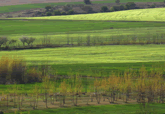For European Union countries (Austria, Bulgaria, Hungary and Romania) and Turkey signed an agreement on 13 July in Ankara, in the presence of the President of the European Commission, to advance the aim of building Nabucco.
As indicated above, one of the consequences of the interruption in Russian gas supply to Central Europe in January 2009 has been the quest for alternatives to such gas. This scenario includes the proliferation of plans for the construction of LNG plants, such as in Croatia, which plans to build a terminal on the island of Krk, in the North Adriatic, which would enter service in 2014, and the Italian group which has signed an agreement to analyse the option of building a terminal in Fier, Albania. Mention should also be made of the Polish decision reached in September to double the initial capacity of the terminal which they are planning, up to a figure of 5 bcm.
Other projects have been deferred as a result of the financial crisis, such as the Skanled gas pipeline, planned to carry Norwegian gas directly to Sweden, Denmark and Poland. Sweden does, however, plan to build an LNG terminal to be located on the outskirts of Nynashamn. This terminal would be operational by 2011.
One aspect worthy of particular mention is that one of the obstacles encountered by the Nord Stream gas pipeline (1200 km from Vyborg, in Russia, to Greifswals, in Germany) preventing its definitive launch was approval from the countries through whose waters it would hassle. The environmental impact has delayed the final investment decision more than had been expected, although in late July the Finnish authorities did give their approval. Sweden followed suit in the month of November,
In Norway, operation of the Ormen Lange field reached its production peak (some 25 bcm per year) in late 2009. It should be remembered that the field lies in Norwegian waters to the north of the country and that production began in September 2007. A part of the output is sent to the United Kingdom after linking up (1200 kilometres of gas pipeline) with the North Sea network. The role of Norwegian gas in the UK market has expanded over recent years, with the Scandinavian country supplying 70% of imports, a figure which is rising as a result of a decline in the UK's own reserves.
Dragon LNG, the new regasification terminal in the United Kingdom (in Waterston, South Wales) began commercial operations on 14 July 2009. It has capacity for 6 bcm per year, extendable up to 9 bcm/year. According to its developers, it has contracted production capacity for the next 20 years.
Also in the United Kingdom it should be mentioned that the country is considering the option of a fourth expansion phase at the terminal located on the Isle of Grain, to the east of London. Work is currently underway on the third expansion phase at the site. As part of this expansion, Centrica, E.ON and Iberdrola have purchased five million tonnes of capacity.
In Italy, the Adriatic LNG offshore terminal located off Porto Levante, Rovigo, was officially opened in spring 2009. By the end of the year it had reached its full capacity of 8 bcm, 20% of which will be available to third-party access.
This is in addition to the Panigaglia terminal, in Spezia (3.5 bcm), to some extent alleviating the lack of LNG offloading capacity present in Italy. Authorisation has so far also been given for terminals in Brindisi (8 bcm), the Tuscany offshore site (3.75 bcm) and the Gas Natural facility in Trieste (8bcm).
The Trieste terminal received its Environmental Approval Decree in summer 2009, bringing to an end the process of authorisation. Gas Natural hopes to have the terminal online during 2013.
At the assessment phase, meanwhile, are the terminals in Risognano (Livorno, 30% BP; 8 bcm), GioiaTauro (Regio Calabria, 12 bcm), Porto Empedocle (Agrigento, over 12 bcm), Trieste Offshore (8 bcm, Endesa) and Ravenna Offshore (8 bcm).
In France, the terminal built in the South West, Fos Cavaou LNG (8.25 bcm), close to the Fos Sur Mer facility, began operations after successive delays. GDF Suez owns a 69.7% stake in the facility.
EDF is interested in building a further terminal in Dunkirk, the location on the English Channel for a gas pipeline bringing Norwegian gas to the French market.
The process was complex (involving as it did two French zones, two pipelines and two countries), and ended with approval for the interconnection via Larrau. The Biriatou interconnection was ruled out on the basis of the 1 GWh/day threshold.
In the Netherlands construction continues on the terminal being built near the port of Rotterdam, which is expected to be completed by mid-2011. The initial capacity of the terminal (9 bcm/year) was expanded to 12 bcm.
Groningen, the main production field in the Netherlands (the European Union's biggest producer) still has a substantial lifespan ahead of it. Modern and more efficient exploitation systems and the favourable use of the existing small gas fields nearby have allowed its current operators to place a figure of 1,033 bcm on the exploitable reserves in the Groningen field.



